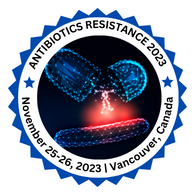Renowned Speakers

Richard W Titball
University of Exeter UK

Andrea Barbarossa
University of Bologna Italy

Georg Daeschlein
University Medicine Greifswald Germany

Martin Duerden
Bangor University UK

Michael kelso
University of Wollongong Australia

Yuxiu Lei
Lahey Hospital and Medical Center USA

Kevin Schrader
United States Department of Agriculture USA

Mario A Bianchet
Johns Hopkins School of Medicine USA
Recommended Global Pharmaceutical Sciences Webinars & Conferences
Europe & UK
Asia Pacific & Middle East
Canada
Antibiotics Resistance 2023
ANTIBIOTICS RESISTANCE 2023
Antibiotics Resistance 2023 invites all the participants from all over the world to attend “9th International Conference on Antibiotics & Antibiotic Resistance’’ scheduled to be held on November 25-26, 2023 we are going to conduct this conference at Vancouver, Canada.The conference invites all the participants across the globe to attend and share their insights and convey recent developments in the field of Antibiotics Resistance. The primary objective of this meeting is to compile researchers involved in antibiotic resistance prevention and control. The meeting will take a unified approach to research and it will bring about researchers specializing in different subjects related to antibiotic resistance.
Conference Series Ltd organizes a conference series of 1000+ Global Events inclusive of 1000+ Conferences, 500+ Upcoming and Previous Symposiums and Workshops in USA, Europe & Asia with support from 1000 more scientific societies and publishes 700+ Open access Journals which contains over 50000 eminent personalities, reputed scientists as editorial board members.
Details of Antibiotics Resistance 2023 Conferences in Canada:
| Conference Name | Place | Date |
|---|---|---|
| Antibiotics Resistance 2023 | Vancouver, Canada | November 25-26, 2023 |
Why to attend?
With members from around the world focused on learning about Antimicrobials & Antibiotic Resistance and its advances in making a better health; this is your best opportunity to reach the largest assemblage of participants from the Antimicrobials & Antibiotic Resistance Committee. Conduct presentations, distribute information, meet with current and potential scientists, make a splash with new drug developments, new treatment techniques and receive name recognition at this 2-day event. World-renowned speakers, the most recent techniques, developments, and the newest updates in Antimicrobials & Antibiotic Resistance are hallmarks of this conference.
Benefits:
- All the accepted speaker abstracts will be published in the respective supporting journals and receive DOI provided by CrossRef.
- Global networking: In transferring and exchanging Ideas.
- Networking with experts in your field.
- Expert Forums.
- Career Development Sessions.
- Best Poster Awards.
- Preconference and Conference Workshops.
- Symposiums on Latest Research.
We invite all the participants to join in Vancouver, Canada to promote Antibiotics Resistance 2023 !
Scientific Sessions / Tracks
Track 1: Origins and Types of Antibiotic and Antimicrobials
The world is in the midst of an emerging crisis of antibiotic resistance to microbial pathogens. Numerous pathogens that have become resistant to commonly used antibiotics have been described in various contexts, including drug-resistant methicillin-resistant Staphylococcus aureus (MRSA), Streptococcus pneumonia, and Mycobacterium tuberculosis. Considering the breadth of effect and significant impact on morbidity and mortality, multi-drug-resistant (MDR) pathogens are a substantial threat to public health. Although this problem calls for the development of new antibiotics with new mechanisms of action, the pharmaceutical industry has abandoned the sector as less lucrative for their investments. The number of new antibiotics approved by the U.S. Food and Drug Administration (FDA) declined dramatically during the past 2 decades.
Track 2: Genetics and Proteomics of antimicrobial resistance
Bacteria can acquire antibiotic resistance genes from other bacteria in several ways. By undergoing a simple mating process called "conjugation," bacteria can transfer genetic material, including genes encoding resistance to antibiotics (found on plasmids and transposons) from one bacterium to another. Antibiotic resistance genes have been identified in diverse environments including soil, gull feces and, increasingly, in the human gut microbiota. Scientists have applied a range of approaches to detect antibiotic resistance genes in environmental or non-clinical microbiomes, all of which have their own inherent strengths/limitations.
Proteomic studies have improved our understanding of the microbial world. The most recent advances in this field have helped us to explore aspects beyond genomics. Proteomics has also advanced our knowledge of mechanisms of bacterial virulence and some important aspects of how bacteria interact with human cells and, thus, of the pathogenesis of infectious diseases. We have used proteomic technology to elucidate the complex cellular responses of Bacillus subtilis to antimicrobial compounds belonging to classical and emerging antibiotic classes.
Track 3: Evolution and Mechanisms of Antibiotics and Antimicrobials resistance
Increasing drug resistance is caused primarily by inappropriate use of antimicrobials in humans as well as in animals, and spread of resistant strains between the two. Antibiotics develop selective pressure in bacterial strength, resulting accessible bacteria to die; this enhances the percentage of resistant bacteria which continue increasing. With resistance to antibiotics becoming more common there is greater need for alternative treatments. New antibiotic therapies have been needed, but new drug development is becoming scarce.
A World Health Organization (WHO) report released April 2014 stated, "This serious threat is no longer a prediction for the future, it is happening right now in every region of the world and has the potential to affect anyone, of any age, in any country. Antibiotic resistance—when bacteria change so antibiotics no longer work in people who need them to treat infections—is now a major threat to public health. Increasing public calls for global collective action to address the threat include proposals for international treaties on antimicrobial resistance.
Track 4:Antimicrobial resistance and its emergence
The use of antimicrobials in animals closely parallels their discovery and usage in humans. Sulfonamide was the first antimicrobial to be introduced to food animal medicine in the 1940s. Antimicrobial resistance emerges from the use of antimicrobials in animals and the subsequent transfer of resistance genes and bacteria among animals and animal products and the environment. Antibiotics are also given to food animals for growth promotion and prophylactic medication. In 2011, a total of 13.6 million kilograms of antimicrobials were sold for use in food-producing animals in the United States, which represents 80% of all antibiotics sold or distributed in the United States. Of the antibiotics given to animals from 2009 through 2013, just above 60% distributed for food animal use are "medically-important" drugs, that are also used in humans. The rest are drug classes like ionophores which are not used in human medicine. here are also global concerns over the use of antibiotics for growth promotion or therapy purposes because of the potential for some drugs to enter the human food chain despite rigorous withdrawal measures and testing to prevent antibiotic residues in food, increasing antibiotic resistance in animals, a potential although largely unproven link to antibiotic-resistant infections in humans, and what some consider antibiotic misuse. When government regulation restricts use of antibiotics the negative economic impact is not often considered.
Track 5:Alternative Strategies for antimicrobial resistance worldwide
There is a renewed interest in the antibiotic sector, which is evident from the most recent patents and investments. Bacterial vaccines and new antibiotic classes are gaining a tremendous amount of attention with several product candidates in clinical development. These new products are expected to change the outlook of the antibiotic sector to a large extent over the next 5 years. Several reports focus on anti-infective markets in general. This report, however, focuses exclusively on antibacterials, with a particular emphasis on the emerging problem of antibiotic resistance. It also includes a detailed analysis of the emerging technology trends, which give a clear picture of the future of the sector. This helps to provide regulatory authorities and industry strategists a better perspective on which to base their decisions. BCC Research published a report on this topic in 2002. Since then, the market has witnessed dramatic changes in terms of technology, investment, and regulatory trends, which are captured in this report.
Track 6:Antimicrobial Resistance: Public Health Concerns
This topic reviews the global antibiotic markets, including discussions on the market development and growth potential over the next 5 years. It also analyses key factors that are driving the market growth. It describes the trends in detail with respect to various antibiotic classes, including the novel classes that are emerging and their technological basis. It includes in-depth discussions of the industry structure and the regulatory environment. It is valuable reading for investors, policymakers, and industry participants. Profiles of leading players in the industry are also included.
Such involved analyses have been conducted to help strategy developers and decision makers within pharmaceutical companies and government bodies. The detailed analyses of the regulatory factors that play major roles in deciding the industry trends are especially useful for legislators involved in government policy development programs. Technology trend and patent analyses give an overview of the new trends with respect to innovation within the sector.
Track 7:Antibiotic surveillance and safety concerns
In the time since penicillin was discovered nearly 80 years ago, antibiotics have become one of the most important lifesaving weapons in doctors' arsenal against bacterial infection. Now, the Lakeland, Fla.-based Publix grocery store chain is giving away seven of these drugs free of charge to those who have prescriptions for them. Five of these are amoxicillin, ampicillin, cephalexin, erythromycin and penicillin VK are commonly used by doctors to treat bacterial infections ranging from ear infections to gonorrhea. But two of the drugs on the list ciprofloxacin and sulfamethoxazole/trimethoprim are high-grade antibiotics that doctors usually reserve for particularly serious infections.
While some hail the program as a godsend, others fear that the move could lead to overuse of the drugs.
This is because the use of antibiotics comes attached with important considerations. According to the American Academy of Family Physicians, there are certain situations in which antibiotics are helpful and many in which they can cause more harm than good.
Penicillins,Cephalosporins,Aminoglycosides,Glycopeptides,Tetracyclines are antibiotics most commonly showing side effects.
Track 8:Analytical strategies for Antimicrobials & Antibiotics
The analysis of antibiotic susceptibility disks by high-pressure liquid chromatography (HPLC) methods are presented for the potency determination of mecillinam, ampicillin, carbenicillin, and cephalotjiin alone and in various combinations. Good agreement between HPLC and microbiological data is observed for potency determinations with recoveries of greater than 95%. Relative standard deviations of lower than 2% are recorded for each HPLC method. HPLC methods offer improved accuracy and greater precision when compared to the standard microbiological methods of analysis for susceptibility disks. The most popular analytical methods for the determination of beta-lactams are the chromatographic ones, including high performance liquid-chromatography (HPLC) and thin layer chromatography (TLC).
HPLC offers high sensitivity and separation efficiency, establishing itself as the first choice method for the analysis of beta-lactams; however it is expensive and requires sophisticated equipment. TLC is a less expensive and less complicated chromatographic procedure, which can be successfully used, in the preliminary screening of pharmaceutical substances. In modern analysis, TLC is usually used as a separation method, which establishes the presence or absence of beta-lactam antibiotics above a defined level of concentration.
Track 9:Role of long term antibiotics & antimicrobial in diseases
Antibiotics have been applied for the treatment of autoimmune diseases for over five decades, based on the premise that infections play a role in the initiation and propagation of these entities. The antibiotics market was valued at USD 39.8 million in 2015 and is expected to witness a CAGR of 4.0% over the forecast period. Increasing efforts are being witnessed toward the development of advanced products. According to the data published by the Pew Charitable Trust, in March 2016, about 37 promising molecules were being investigated within the U.S. market. Majority of these, are in phase II clinical trials and are anticipated to hit the market between 2018 - 2020. Furthermore, supportive government legislations, such as the Generating Antibiotics Incentives Now (GAIN) Act are expected to expedite the approval process. GAIN Act has provisions which facilitate development of therapy against antibiotic resistant pathogens.
Antibiotics are a type of antimicrobials that are used in treatment and prevention of bacterial infections. They may kill or inhibit the growth of bacteria. Many antibiotics are also effective against protozoans and fungi; some are toxic to humans and animals also, even when given in therapeutic dosage. Antibiotics are not effective against viruses such as common cold or influenza, and may be harmful when taken inappropriately. Physicians must ensure the patient has a bacterial infection before prescribing antibiotics.
Track 11:Antibiotic Resistance: Opportunities and Challenges
Certain bacterial infections now oppose all antibiotics. The resistance problem may be reversible, but only if society begins to acknowledge how the drugs affect "good" bacteria as well as "bad". Historically, most antibacterials were used in hospitals, where they were integrated into surgical clothes and soaps to limit the spread of infection. More recently, however, those substances (including triclosan, triclocarbon and such quaternary ammonium compounds as benzalkonium chloride) have been mixed into lotions, dish-washing detergents and soaps meant for general consumers. They have also been impregnated into such items as cutting boards, toys, high chairs and mattress pads.
Track 12:Antibiotics in Different Industries
Antibiotics must be used accordingly in humans and animals because both uses share to the emergence, persistence, and escalation of resistant bacteria. Resistant bacteria in food-producing animals are of particular concern. Food animals play as a source of resistant pathogens and resistance mechanisms that can directly or indirectly result in antibiotic resistant infections in humans. Resistant bacteria may be transmitted to humans through the foods we eat. Some bacteria have turned resistant to more than one sort of antibiotic, which makes it more difficult to treat the infections they cause. Sustaining the efficiency of antibiotic drugs is vital to insulating human and animal health.
Track 13:Micro Organisms in Recent Drug Discovery
Environmental microbes are a leading source of drug discovery, and several microbial products ( anti-tumour products, antibiotics, immunosuppressants and others) are used frequently for human therapies. Most of these products were accessed from cultivable (<1%) environmental microbes, means that the large number of microbes were not targeted for drug discovery. With the onset of new and emerging technologies, we are poised to harvest novel drugs from the so-called 'uncultivable' microbes. Multidisciplinary way of linking different technologies can assist and reform drug discovery from uncultivable microbes and inspect the current cramp of technologies and scenario to swamped such constraints that might further expand the promise of drugs from environmental microbes.
Track 14:Clinical Trials of Antibiotics
Prescribing doctors are, progressively, using clinical trial data as a major source of information for evidence-based medicine for the remedy of infectious diseases, as in other clinical disciplines. However, it may be difficult to excerpt from these data the material that is needed for the management of the individual patient. At the same time, clinical trial testimony have been used, probably satisfactorily, in the process of drug registration, and the pharmaceutical industry has spent progressively large amount of money to satisfy the needs of this process. In the face of all these problems, switch in the way antibiotic clinical trials are designed and performed are clearly necessary, although this must not disturb the balance so far as to restore them less useful for those who currently derive greatest benefit from them.
Track 15:The Next Generation Approach of Antibiotics
The discovery of a new antibiotic called teixobactin was announced by international team of researchers, in January this year. It is the most significant new antibiotic to be discovered in more than 30 years, and it may help combat the growing number of drug-resistant bacteria.
Track 16:Alternative to Antibiotics
This new method uses the enzymes of bacteriophages to attack the bacteria. Bacteriophages are tiny viruses that infect bacteria. After they infect the bacteria, they replicate or make copies of themselves, and then leave the bacteria to go and infect other bacteria. To be able to leave the bacteria, the "phages" make an enzyme that dissolves the wall of the bacterial cell, thus killing it.
Market Analysis
Antibiotic usage varies Globally:
Antibiotics changed the world. General deals in the present antibiotics and new products advertise were about $48 billion in 2019. It expanded to $51.5 billion in 2021. By 2025, it is anticipated to increase to $77.5 billion, for a 5-year compound annual growth rate (CAGR) of over 9.6%.
Commonly used antibiotics with their increased percentage of resistance
The antibiotics market generated sales of US$52 billion in 2019 all inclusive, representing 46% of sales of anti-infective agents (which additionally incorporate antiviral medications and vaccines) and 5% of the worldwide Pharmaceutical Market. However, the antibiotics market is maturing; it demonstrated a normal yearly development of 4% in the course of recent years, contrasted and a development of 16.7% and of 16.4% for antiviral medications and vaccines, individually.
The worldwide foundational antibiotics market was esteemed at $39.6 billion in 2013 and is relied upon to reach $61.2 billion by 2025, at a CAGR of 0.8%. Since, 2015 this market apparently grows at a yearly rate of 7.6% until 2021. There are many organizations manufacturing antibiotics nowadays and there are numerous different antibiotics present in the market, for example, aminoglycoside antibiotics and it covers around 79% of the worldwide demand. In addition, alternate antibiotics, for example, pencillin have 8%, tetracyclines 4%, erythromycin 7%, streptomycin 1% and chloramnphenicol has 1 % market.
Organizations working on Antibiotics around the Globe:
- Infectious Diseases Society of America
- World Health Organization
- U.S. Food and Drug Administration (FDA)
- Center for a Livable Future (CLF)
- Centers for Disease Control and Prevention (CDC)
- American Medical Association
- Animal Welfare Approved (AWA)
- Center for Food Safety
- Center for Science in the Public Interest (CSPI)
- Food Animal Concern Trust (FACT)
- The Humane Society of the United States (HSUS)
- The Pew Charitable Trusts
- Food and Water Watch
- Healthy Food Action
- Keep Antibiotics Working (KAW)
- Natural Resources Defense Council (NRDC)
- American Nurses Association
- American Public Health Association
- Institute of Medicine, National Academies of Science
- American Society for Microbiology
Visa Requirements
Planning a Trip to VANCOUVER, BRITISH COLUMBIA, CANADA!! Attending Meeting!!!
Issue with VISA!!
Participants requiring a visa should apply immediately to the consular office or embassy in their country in order to avoid inconvenience. Please note that the visa application procedure can take some weeks.
The Program organizer can assist the attendees by processing official invitations upon request after registering for the conference. This letter of invitation, however, constitutes neither an obligation by the Local Organizing Committee to cover any travel and accommodation expenses, fees or other costs connected with attending the meeting and staying in Vancouver, Canada.
The deadline for requesting a Letter of Invitation is one month before traveling to Canada via. E-mail:: antibiotics@eventsupporting.org
To Collaborate Scientific Professionals around the World
Conference Date November 25-26, 2023
For Sponsors & Exhibitors
Speaker Opportunity
Useful Links
Past Conference Report
Supported By
All accepted abstracts will be published in respective Conference Series International Journals.
Abstracts will be provided with Digital Object Identifier by



